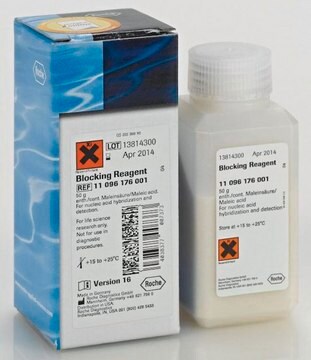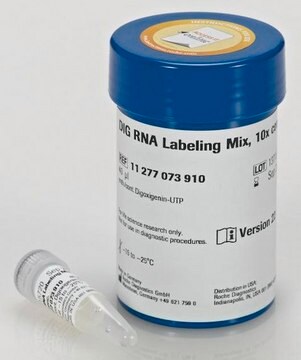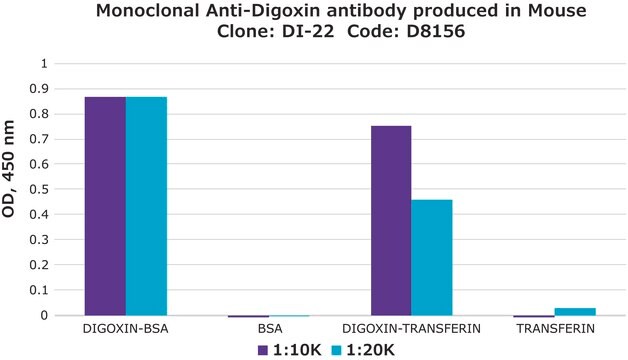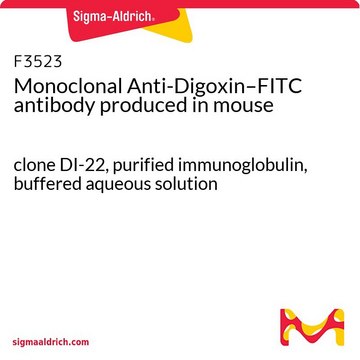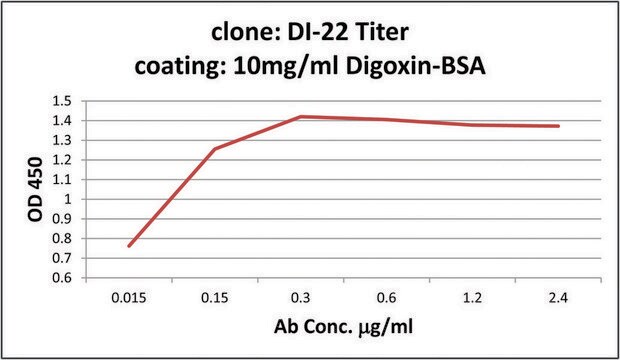11207733910
Roche
Anti-Digoxigenin-POD, Fab fragments
from sheep
Sinonimo/i:
anti-digoxigenin, digoxigenin
About This Item
Prodotti consigliati
Origine biologica
sheep
Livello qualitativo
Coniugato
peroxidase conjugate
Forma dell’anticorpo
F(ab′)2 fragment of affinity isolated antibody
Tipo di anticorpo
primary antibodies
Clone
polyclonal
Forma fisica
lyophilized (clear, brown solution after reconstitution)
Confezionamento
pkg of 150 U
Produttore/marchio commerciale
Roche
Temperatura di conservazione
2-8°C
Descrizione generale
Specificità
Applicazioni
- Dot blot
- ELISA
- Immunohistocytochemistry
- In situ hybridization
- Western blot
Nota sulla preparazione
Working concentration: Working concentration of conjugate will depend on the application and substrate. The following concentrations should be taken as a guideline: Dot blot: 150 mU/ml
- ELISA: 50 to 150 mU/ml
- Immunohistocytochemistry: 250 to 500 mU/ml
- In situ hybridization: 1.5 to 7.5 U/ml
- Southern blot: 150 mU/ml
- Western blot: 250 to 500 mU/ml
Working solution: 100 mM Tris-HCl, 150 mM NaCl, pH 7.5.
1% Blocking reagent (w/v), 1 to 5% heat inactivated fetal calf serum (v/v) or sheep normal serum can be used for reduction of unspecific binding.
Ricostituzione
Altre note
Non trovi il prodotto giusto?
Prova il nostro Motore di ricerca dei prodotti.
Avvertenze
Warning
Indicazioni di pericolo
Consigli di prudenza
Classi di pericolo
Skin Sens. 1
Codice della classe di stoccaggio
11 - Combustible Solids
Classe di pericolosità dell'acqua (WGK)
WGK 1
Punto d’infiammabilità (°F)
does not flash
Punto d’infiammabilità (°C)
does not flash
Certificati d'analisi (COA)
Cerca il Certificati d'analisi (COA) digitando il numero di lotto/batch corrispondente. I numeri di lotto o di batch sono stampati sull'etichetta dei prodotti dopo la parola ‘Lotto’ o ‘Batch’.
Possiedi già questo prodotto?
I documenti relativi ai prodotti acquistati recentemente sono disponibili nell’Archivio dei documenti.
I clienti hanno visto anche
Articoli
Digoxigenin (DIG) labeling methods and kits for DNA and RNA DIG probes, random primed DNA labeling, nick translation labeling, 5’ and 3’ oligonucleotide end-labeling.
Il team dei nostri ricercatori vanta grande esperienza in tutte le aree della ricerca quali Life Science, scienza dei materiali, sintesi chimica, cromatografia, discipline analitiche, ecc..
Contatta l'Assistenza Tecnica.
